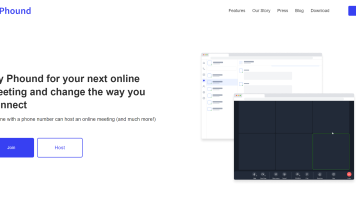As companies continue to rein in costs the reality they face is they still need to operate – make widgets, fix widgets or distribute them with less resources. You see regardless of business type, productivity is important and even if there are less employees and smaller travel budgets, the show must go on.
Enter technology – the major casualty of the dotcom bust – the initial cause of the last recession.
But this recession while so many market segments are truly hurting, tech has emerged as a resilient sector. And this is true in a market where some analysts believe real unemployment numbers in the US are greater than 10% already.
Polycom released earnings this week and while they were below last year they were above analyst estimates and showed the company plays in areas of tech strength. For example voice communications revenue remained flat at $69 million while the unemployment rate is just under double last year. More importantly the video products business grew 3 percent quarter-over-quarter to $161.7 million and to learn more I visited the company’s New York showroom this past week.
I met with Bob Preston, VP Industry Solutions and Caroline Japic, Senior Director Corporate Communications. Preston has a team of ten who focus on vertical markets such as healthcare and education and this group has literally embed themselves in the industries they cover by becoming part of associations and even heading them up. They serve as a huge funnel where their customer contact allows them to help determine market need while feeding the company valuable success stories and case studies.
This team in fact is becoming helpful to companies that have cut travel budgets but need to continue to be productive according to Preston. He further went on to describe how HD telepresence in the offshoring market has been growing as companies need to be able to see remote circuit boards, garments and other products for approval before production begins.
In another example, the Polycom execs told me of TV shows which are shot on the east coast with a creative staff on the west coast. It is the videoconferencing technology which allows the studio to produce shows more productively.
While we were having our discussion we sat in a custom telepresence room called RPX which costs in the $200,000 range and we spoke with a remote representative in another telepresence room. In our meeting of over an hour it became difficult to distinguish the virtual from real. The technology has gotten that good.
Some videos of the fully immersive RPX telepresence solution
This demo is what they call fully immersive for obvious reasons but I was not 100% thrilled with the rear projection monitors in use as angled viewing was not 100% perfect. In other words some of the monitors were a bit darker than others. I was told the reason for this selection of monitor is the size of the monitors allows you to see the entire person and that for long-term viewing rear projection is a better solution. It is worth mentioning I have noticed this same slight problem in demos from other vendors as well.
We then went into the TPX telepresence room which is based on plasma TVs and by comparison these sets weren’t as soft on the eyes and in addition they didn’t allow you to see the same height as the rear projection units.
While companies know deploying technology can increase their productivity, many of these same organizations have CAPEX freezes in place so Polycom rolled out a leasing option last month to be able to utilize corporate OPEX budgets in equipment purchases.
I asked how the company is differentiating itself and was told they are happy Cisco is in the market as they welcome their ad dollars. This was a reference to how the networking company’s’ dollars are helping to expand the market as a whole.
From there they discussed how they embrace open standards like H.323 and SIP while Cisco does not – they speak to themselves. Japic said, “Can you imagine if you had to call people with same cell phone model?” In addition the company touted its depth and breadth of product line – Solutions from $3,000 to $300,000. They contrasted this to Cisco who they believe is in the video market to push more boxes referring to the incremental need for switching gear needed to handle the increasing bandwidth produced by video-based solutions.
At the lower end of the market is LifeSize and Japic’s comments on this Texas-based company is, “they give you a kit and say good luck,” referring to the holistic approach Polycom takes to selling complete solutions including monitors as opposed to a more segmented or piecemeal approach.
They did acknowledge LifeSize does compete on the lower end of the market and they have seen them show up in education RFPs.
From there I was told about all the value Polycom adds to the educational market. Solutions such as a video-enabled social network CAPspace which allows educators with similar skillsets or job responsibilities to network. For example third-grade teachers from Peoria to Philadelphia can collaborate on how best to teach. The solution further allows connectivity to museums, sports halls of fame and more.
To seal the deal there is also Polycom’s support of Global Nomads, a group which explores the world and shares the experience with classrooms around the world.
Thomas Henkel, VP of Sales for the NY-Metro region Extols the virtues of Polycom’s desktop VVX 1500 solution – on the product he is touting
Asked about competition from the low-end such as Skype the answer was that these solutions are fine for the consumer but for business where quality is important and you need the ability to conference numerous people you need to step up to a business-class solutions.
Asked what’s next the company mentioned VC2 which we might call as an industry video conferencing 2.0. In Polycom’s own words, “VC2 transforms traditional video conferencing into visual communication. With VC2, video is a pervasive component of enterprise communication–on desktops, in meeting rooms, on mobile devices.”
As a leader in video, more video usage means more Polycom solutions will be sold. And as more of the world becomes video-enabled it seems to me the ability for technology to continue boosting productivity only grows. And this isn’t just talk. Metcalfe’s Law states the value of a telecommunications network is proportional to the square of the number of users on the system. The easiest way to understand the concept is by thinking to yourself, what is the value of one fax machine? Two? Ten, 1,000?
So as video proliferates so does the value of the video network meaning every investment in videoconferencing solutions increases productivity by that much more. And that my friends is why I love this business so much. And so should you.
I strongly urge you to listen to Bob Preston speak live about how video-enabled solutions can boost productivity at your company – he will be at ITEXPO Wednesday, September 2, 2009 in Los Angeles. Register now





